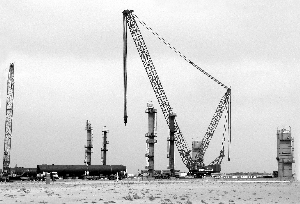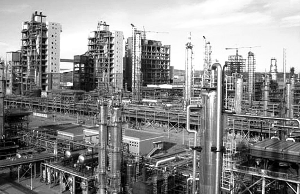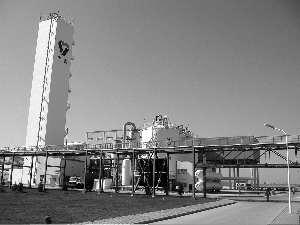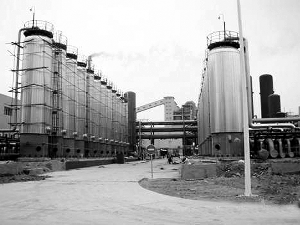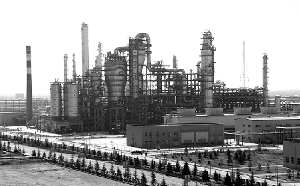China’s first coal-based natural gas demonstration project under construction—Datang Corporation’s Inner Mongolia Keqi Coal-to-Gas Natural Gas Project construction site. As of 10:00 on August 24th, Shenhua Group's coal-to-olefins project produced a total of 4866 tons of polyolefins, with an average loading rate of 70%, a methanol conversion rate of 100%, and a diene selectivity of 80.3% with ethylene and propylene. Both important indicators of conversion and selectivity meet the design requirements. The device was running smoothly. Academician Chen Junwu, a member of the Luoyang Research Institute of Sinopec, who was watching the car at the scene, said: “The device is running smoothly and unexpectedly.†The success of this demonstration project marked the completion of five demonstration projects for nine modern coal chemical projects deployed by the National Development and Reform Commission, including four demonstration projects for coal to oil, coal to olefins, and coal to ethylene glycol. At the same time, people's attention to coal chemical demonstration projects has once again become a hot spot. Xinao Group, established and put into operation in September 2009, has an annual output of 400,000 tons of coal-made dimethyl ether plant. Independent intellectual property rights gave birth to the batch of coal chemical demonstration projects. The biggest bright spot was that the core technology of the project adopted technology with Chinese independent intellectual property rights. When Shenhua Group began to build coal-to-olefins projects, they first took a look at the world-class U.S. global company's methanol to olefins technology, but soon they were attracted by the advanced methanol-made low-carbon olefin technology of the Dalian Institute of Chemical Physics of the Chinese Academy of Sciences. eyeball. Based on the solid foundation of China's large coal chemical industry, Dalian Institute of Chemicals has been conducting research on methanol-to-olefin technology since 1980, and has strived to enter the international leading ranks. In August 2006, the methanol-to-olefin technology completed a 10,000-ton industrial trial. According to expert assessments, the conversion rate of methanol was 99.18%, the selectivity of ethylene plus propylene was 78.71%, and the amount of methanol consumed per ton of olefin was 2.98 tons. The Shenhua Group's coal-to-olefins project ultimately selected the Dalian Institute of Technology and is also the best technology in the world today. Another highlight of these coal chemical demonstration projects is that the project installations are the first in the world or the main process technologies for the first time at home and abroad. The 1.08 million tons/year direct liquefaction coal oil demonstration project built by Shenhua Group in Erdos, Inner Mongolia, adopts the domestic coal direct oil production technology researched and developed over 20 years ago. It is the world's first special design and construction based on its own technical strength. Large coal direct liquefaction oil-making device. On December 30, 2008, the device was successfully commissioned. As of August 24, 2010, the cumulative investment time for the device exceeded 5,578 hours. The cumulative production of oil products was 526,600 tons, the coal conversion rate was 90.94%, and the distillation oil yield was 56. %~57%. The longest continuous operation time reached 4 months, the equipment load rate was 85%, and the operation was stable. The oil produced is ultra-clean transportation fuel, which is very beneficial to the environmental protection of the city. The 200,000-ton/year coal-to-ethylene glycol demonstration project built by Inner Mongolia Tongliao Gold and Coal Chemical Co., Ltd. is also the world's first large-scale industrialized unit for coal-to-ethylene glycol. The project was successfully completed in December 2009. The project has completely adopted the technology with Chinese independent intellectual property rights. The Institute of Material Structure of the Chinese Academy of Sciences, the Institute of Material Structure of the Chinese Academy of Sciences, has made unremitting efforts for 30 years and finally achieved this internationally leading level of technical achievement. . The success of this project has achieved the extension of the traditional coal chemical industry to the petrochemical industry, which is of great significance to ease the shortage of domestic petroleum and petrochemical products. At the same time, it should be noted that there are still many important technical equipments to be imported from abroad. The Shenhua Group's coal-to-olefins project is the introduction of its own technology, with the exception of the core methanol-to-olefin technology. For example, the gasifier uses seven 1,500 tons of daily coal-fired coal-slurry gasifiers from the U.S. General Motors Co., Ltd., which is the most mature Texaco furnace in the country. 2 x 265,000 standard cubic meters per hour of syngas purification equipment, adopting German Linde's low-temperature methanol wash process; 1.8 million tons/year methanol plant, adopting British David's low-pressure methanol synthesis technology; 300,000 tons Ethylene, 300,000 tons of propylene/year olefin separation and purification device, using the United States Lums company's frozen purification technology. Therefore, accelerating the development of key equipment and complete sets of technical equipment for coal chemical industry is an urgent issue to be solved in the development of modern coal chemical industry. In December 2008, Shenhua Group, which was completed and put into production, produced 1.08 million tons of direct coal-to-oil projects in Ordos. Gasifiers are tamed to develop modern coal chemical industry, and mastering the operation technology of large gasifiers is the key. In domestic coal chemical demonstration projects, large-scale gasifiers are one of the major necking equipment. At present, the enterprises of the demonstration project have found out a wealth of operational experience, and developed a way for domestic and foreign counterparts to develop modern coal chemical industry. Since the Shenhua Group's coal-to-oil demonstration project was put into operation on December 30, 2008, its insufficient supply of hydrogen has been a factor that affects the full-load operation of the device. The two Shell gasifiers responsible for hydrogen production experienced more breakdowns and failed to reach the design's operating cycle and load. Through the exploration of optimizing coal blending, optimizing production operations, and adding ceramic filter elements for dust remover, the company has extended the operating cycle of coal hydrogen production. At the same time, the company also added a set of natural gas hydrogen production equipment to protect the hydrogen supply. Shell furnaces of another company in China have experienced shell temperature rises approaching the design value of the equipment during operation. The analysis found that the coal conversion rate was too high and the flow field in the furnace changed. Through the shutdown and overhaul, proper adjustment of the position of the balance hole, the latest operating data show that the housing temperature is greatly reduced. Some Shell furnaces exhibit syngas cooler fouling, resulting in high outlet temperatures. Shell companies in the United Nations conducted a detailed investigation of this issue, adopting coal blending, stable gasification operations, optimizing the amount of burner steam addition and other measures to solve this problem. The breakage of the ceramic filter element of the syngas deduster is a multiple failure of the Shell furnace. The service life of ceramic filter elements varies from one company to another, typically between six months and two years, and up to three years. However, some companies have broken in only a few weeks. Analysis of the reasons found that this is due to fly ash accumulation between the filter elements to form a bridge, bearing weight exceeds the filter material strength. By real-time monitoring of the situation of the reversing valve, setting different blowback frequency according to the load and the characteristics of the coal, the damage of the filter element is reduced, and the service life of the filter is improved. Some enterprise shell furnaces appear abrasive erosion at the joint between the gasifier and the syngas cooler. When the shell furnace is severe, it causes the slag to fall off and the cooler leaks. Through the strict control of refractory mud coating construction quality, selection of appropriate refractory materials and other measures to reduce erosion. According to the experience of many Shell coal gasifier manufacturers, the life of refractory mud at this connection can exceed two years. At present, China has independently developed a variety of advanced gasification furnace technology, while also introducing a large number of furnace types. According to incomplete statistics, there are 42 multi-nozzle opposed coal-water slurry gasifiers for domestically-built gasifiers that have been put into operation and under construction, 103 multi-component slurry semi-water-wall gasifiers, and 22 space furnaces. Poly gasification furnace 23 sets. The gasifiers introduced by domestic enterprises include 57 U.S. general coal-water slurry gasifiers, 23 Shell dry gasifiers, 7 GSP gasifiers, and 1 U-GAS gasifier. In the production practice, domestic enterprises have resolved the failures in gasifier production many times, and gasification furnace production technologies with great difficulty in operation are gradually being grasped by domestic enterprises. The Inner Yitai Group, which was completed and put into production in March 2009, has an annual output of 160,000 tons of coal indirect liquefaction oil production unit. The “Twelfth Five-Year Plan†production practice of speed-up demonstration projects shows that under the background of high international crude oil prices, the use of coal chemical technology to produce these products is showing greater and greater economy. It is estimated that the production of olefins in the petroleum route requires approximately 2 tons of naphtha or light diesel oil per ton of olefins produced, while the production of 1 ton of coal-based olefins produced by the Shenhua Group demonstration project consumes only approximately 3 tons of methanol. According to the data of August 2010, the domestic market prices of naphtha and light diesel oil are currently over 5,500 yuan per ton, while the market price of methanol is only around 2,200 yuan per ton. If the project is constructed at the pit of a coal mine and equipped with an economical large-scale installation, the full cost of coal-based methanol can be made even lower. The cost advantage of coal to olefins is obvious. Liu Zhongmin, deputy director of the Dalian Institute of Chemicals, conducted a preliminary analysis. Taking Shenhua Group's annual output of 600,000 tons of coal to produce olefins, Shenhua Group's gasification coal price is about 420 yuan per ton, boiler coal price is about 250 yuan per ton, and the rail transportation distance is 170 to 200 kilometers. The calculation shows that when the average coal price is 400 yuan per ton, the naphtha olefins cost equal to the cost of coal to olefins, the price of crude oil used must be less than 30 US dollars per barrel, and now the international oil price has been around 80 US dollars per barrel. . "Obviously, the coal-to-olefins production route has a very significant economic competitiveness." Liu Zhongmin said. CCIN reporter learned from Shen Geping, chief engineer of the Shenhua Group's coal-oil branch company, that the cost of the coal-to-oil production of the Shenhua Group was calculated at an annual output of 1.05 million tons of refined oil, with a total cost of 3058 yuan per ton of oil. In order to achieve this cost, the oil used for crude oil refining must be used at a price below US$47.85 per barrel. Yao Yuangen, one of the world’s first inventors of 200,000-ton/year coal-based glycol technology and deputy director of the Fujian Institute of Materials Construction, told CCIN reporters that the cost of coal-based glycol produced in Tongliao, Inner Mongolia, is approximately RMB 3,000 per ton. This is in sharp contrast to the current price of more than 6,500 yuan per ton of petroleum-based ethylene glycol sold on the market. It is to see the huge economic performance demonstrated by the coal chemical demonstration projects. Several major domestic petrochemical companies have changed their previous rejection attitudes and started to develop into the coal chemical industry. On February 3, 2010, Sinopec and Henan Coal Chemical Industry Group signed a letter of intent for cooperation in the coal chemical integration project, and reformed the raw material route of raw materials for ethylene. In the words of Chen Xuefeng, chairman of Henan Coal Chemical Group, "it is necessary to co-operate in the coal-to-olefins project." In April 2010, China National Offshore Oil Corporation and Datong Coal Mining Group reached a cooperation to use Datong's medium- and low-calorific-value coal as raw materials to build a set of 4 billion cubic meters per year of coal-to-natural gas projects, with 410,000 by-produced tars. Tons/year, naphtha 80,000 tons/year, *yellow 180,000 tons/year,*ammonium 80,000 tons/year, and total investment is expected to be 20.8 billion yuan. On May 20th this year, Sinopec Nanjing Chemical Company and Shanxi Lanhua Coal Industry Group signed a cooperation agreement in Shanghai. The two parties will jointly build an annual production of 1.8 million tons of methanol and 600,000 tons of olefins projects in Jincheng City, Shanxi Province. The total investment of the project is 18 billion yuan. CCIN reporter recently learned from Wang Yuejun, head of coal chemical project department of Sinopec Yizheng Chemical Fiber Co., Ltd., that the company is currently planning to build 1.8 million tons of methanol and 600,000 tons of coal-to-olefins projects in Huainan, Anhui Province. The project will be funded by Sinopec and Anhui Province. 50% building. During the “Eleventh Five-Year Plan†period, many localities put forward plans for the development of modern coal chemical industry, because Shenhua Group's demonstration projects such as coal-to-oil, coal-to-olefins, etc. did not come out, and these plans were all put aside in the state approval. Now that these large-scale demonstration projects have been completed and put into production, and show good technical feasibility and investment economic benefits, then the “Twelfth Five-Year Plan†that will start next year is not about to open the gate to a batch of modern coal chemical projects? On this issue, the CCIN reporter noted the position of experts and officials. Gu Zongqin, director of the Institute of Petroleum and Chemical Industry Planning, said: “Now several major demonstration projects are running so well. The Shenhua Group’s coal-to-oil project has a load of more than 80%, and the Yitai Group’s indirect coal-to-oil demonstration project was completed on March 27, 2009. The daily production has been stable, the load has remained at 100%, and the product supply is in short supply. The benefits are so good. What are the reasons for not allowing development? I expect that modern coal chemical industry will develop more in the 'Twelfth Five-Year' than 'Eleventh Five-Year'. fast." In December 2009, the 200,000 tonne/year coal-to-ethylene glycol demonstration plant of Inner Mongolia Tongliao Gold and Coal Chemical Co., Ltd. was successfully tested. On August 21, 2010, the successful Shenhua Group Baotou 600,000 tons/year coal-to-olefin plant was launched. (Photo by Liu Fangbin Hu Yuejun Chen Danjiang) Galvanized Open Cell Ceiling System Galvanized Open Cell Ceiling System,Galvanized Ceiling Tiles,Galvanized Ceiling Panels,Ceiling Tile Grid System Foshan Nanhai Lianxing Deli Decoration Materials Co.,Ltd , https://www.tuodeli.net